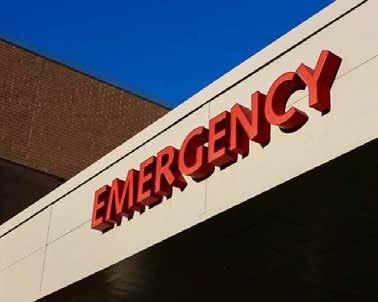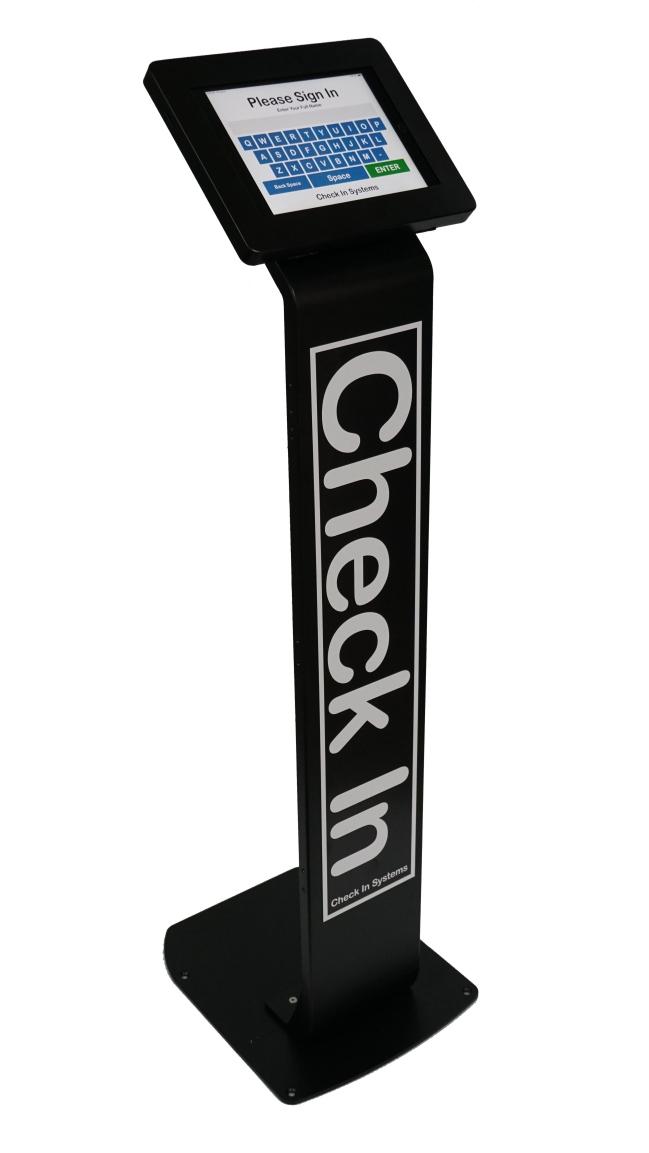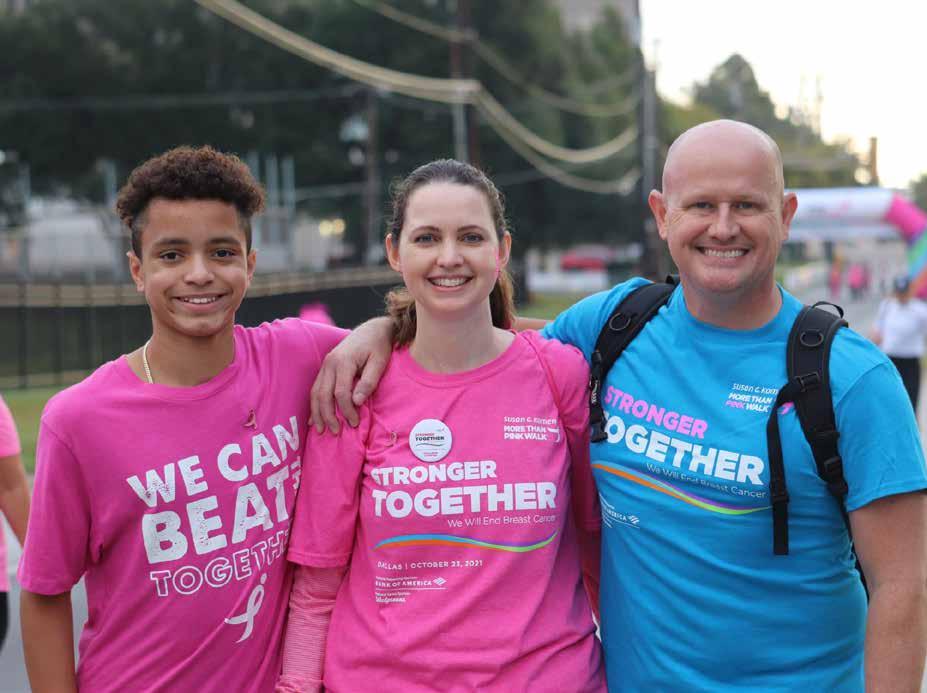Why Breast Cancer Patients Need Help Now More Than Ever How Joining Susan G. Komen®’s MORE THAN PINK Walk in Central Texas Will Raise Money For Cutting-Edge Breast Cancer Research and Critical Patient Services



 By Jeannine O’Deens, Executive Director of Susan G. Komen, Central Texas
By Jeannine O’Deens, Executive Director of Susan G. Komen, Central Texas

Breast cancer patients need help today. Now, it is more critical than ever to provide much-needed support to help those facing breast cancer because there are more burdens and barriers to care that they face due to the aftermath of the pandemic and the current economic slow-down adding personal financial stress.
On October 30, Susan G. Komen® will hold its in-person MORE THAN PINK Walk Central Texas in Austin to raise critical funds that provide direct patient services to address the economic, medical, social, and emotional (psychosocial) impact of a breast cancer diagnosis.
Why now?
We have seen a tremendous increase in demand for our services because of the additional financial barriers caused by the economic slowdown.

Financial Need
The financial toll caused by





cancer often surprises patients. Basic costs of living like transportation, childcare, and housing costs become more challenging as well as any possibility of saving for retirement. Known as financial toxicity, breast cancer patients often deal with high costs from treatment and managing related side effects. This can take a huge emotional, mental and physical toll.
We are seeing this firsthand, that the aftermath of the pandemic has exacerbated this financial toxicity due to the impact it has on the economy and personal finances.

The Komen Patient Care Center has seen an increase in calls since this time last year and over 60% of those callers are in active treatment and seeking financial support. At the current rate, the demand for financial assistance will increase by 81% this year compared to last year. We estimate needing another $2.6 million in funding this year to be able to meet the demand and help keep people in
treatment. Delays in screening and treatment
Also, we are also concerned about how breast cancer screenings and treatment were significantly disrupted due to the pandemic causing additional challenges and barriers to much-needed breast cancer care. The screening delays and cancellations during the pandemic raised concerns about associated increases in late-stage cancer diagnoses and mortality.
We know 1 in 8 women in the U.S. will be diagnosed with breast cancer in her lifetime- the need for help for patients today is more urgent than ever. Now is the time for us to invest in providing breast cancer patients the care they deserve and fund researchers hard at work in search of the cures.
How can you help?
We can help reduce breast cancer deaths by 30% by giving people access to the care and support they need today. This year’s MORE THAN
PRSRTSTD USPOSTAGE PAID PERMITNO1 HOUSTONTX PERMIT#1149 AUSTINTX October Edition 2022Volume 5 | Issue 10 see Breast Cancer...page 14
Medicaid Expansion May Reduce Emergency Department Visits for Non-Emergencies See pg. 11 Inside This Issue Culinary Medicine Programs Aim to Improve Nutrition Education for Doctors See pg. 12 INDEX Legal Matters pg.3 Oncology Research pg.4 Mental Health pg.6 Healthy Heart pg.8 Hospital News pg.10

Austin Medical TimesPage 2 October 2022 austinmedtimes.com
Sarah Kocher, J.D. Polsinelli, PC

CMS recently released the 2023 Outpatient Prospective Payment System proposed rule (“OPPS Proposed Rule”), with notable provisions such as enrollment and payment policies for the newly established “rural emergency hospital” provider type. Also notable is a topic that is not addressed in the OPPS Proposed Rule – co-location. The OPPS Proposed Rule does not include any discussion of, or even nod to, the status of co-location under the Medicare Provider-Based rules. For hospitals attempting to create an effective strategy around co-location, and that have been riding a rollercoaster of CMS guidance on this


topic, the lack of concrete guidance is likely frustrating…but no news may ultimately be good news for hospitals. An Overview of Co-Location. Co-location can take a range of forms, but generally occurs when a Medicare provider such as a hospital shares space with another healthcare entity. CMS regulates co-location under two primary sets of rules and guidance: (1) Medicare Conditions of Participation (“CoPs”) and (2) Medicare Provider-Based rules.
The distinction between the CoPs and the Provider-based rules is important. CoP and Provider-Based guidance come from separate divisions within CMS – the CMS Quality, Safety & Oversight Group, for updates and guidance relating to the CoPs, and the CMS Payment Policy Group, for updates and guidance involving the Provider-Based rules. Further, although there is some overlap, the CoPs and Provider-Based rules have distinct sets of requirements for compliance, as well as distinct penalties for failure to
comply.
The CoPs and Provider-Based rules do not directly address co-location, but for nearly a decade, CMS interpreted the CoPs and Provider-Based rules as prohibiting a hospital from sharing nearly any space with another health care provider. Then, in November 2021, CMS issued final updates to the Medicare State Operations Manual, laying out a pathway for co-location under the general acute care hospital CoPs. Despite this opening under the CoPs, there has been no counterpart CMS guidance regarding co-location under the Medicare Provider-Based rules. And with the lack of any discussion around co-location in the OPPS Proposed Rule, CMS is not engaging in formal rulemaking regarding co-location under the
Provider-Based rules at this time. But where does this leave hospitals?
The Status of Co-Location and the Provider-Based Rules.
Although CMS has not issued any recent guidance regarding co-location under the Provider-Based rules, there have been adjacent developments at the federal level that will likely impact any position that CMS ultimately takes. First, in Azar v. Allina Health Services, the United States Supreme Court held that CMS must utilize notice-and-comment rulemaking when establishing a “substantive legal standard” that would govern the scope of Medicare benefits, payment conditions, or eligibility to furnish services. In follow-up to Allina, on December

Medical Check In
Austin Medical Times Page 3 October 2022austinmedtimes.com
Improving customer service with technology As low as $34 / month 800-971-8871 www.medicalcheckin.com Fast Patient Sign In Process Organizes Patients by Reason HIPAA Compliant TX-RAMP Certified Unlimited Data Unlimited Support Legal Matters CO-Location and The Provider-Based Rules –No News Is…Good News?
see Legal Matters...page 14
Oncology Research Breast Cancer Surgery: What Are My Options?
By Bridget O’Brien, D.O., FACS, FSSO, Texas Breast Specialists–Cedar Park, Georgetown

growth and progression
• To relieve symptoms found in advanced stages
• To cosmetically reconstruct the breast(s) after cancer surgery
When a woman is diagnosed with breast cancer, a million thoughts run through her head. What type of breast cancer do I have? How quickly is it growing? Has the cancer spread? Will I lose one or both of my breasts?
All of this can have a profound impact on the treatment decisions a woman makes – especially in cases where breast surgery may play a pivotal role in their overall treatment plan. In fact, surgery is one of the primary treatments for breast cancer and is used:
• As a diagnostic and treatment tool to determine the cancer’s
• To reduce breast cancer risk for those with higher risk, such as women with an immediate family member who has had breast cancer, or those whose genetic tests indicate a mutation that conveys a high risk of breast cancer

Excluding skin cancers, the World Health Organization reports that breast cancer is the most common form of cancer worldwide. In Texas, over 21,000 women are expected to face a new diagnosis of breast cancer in 2022, according to the American Cancer Society. How to decide which breast surgery is right for you
Surgery for breast cancer depends on several factors including the size and location of the tumor(s), stage of cancer, treatment options,
and individual goals and preferences. While surgery will not fully treat metastatic breast cancer, it can be helpful to treat one site with significant symptoms.
Common surgical procedures used to treat breast cancer include breast-conserving surgery and mastectomy.
• Breast-conserving surgery, also referred to as a lumpectomy, quadrantectomy, or partial mastectomy, removes the area of cancerous tissues from the breast without removing the entire breast.
• Mastectomy is the surgical
removal of an entire breast. It is usually performed when a patient cannot be treated with lumpectomy. In some cases, mastectomy will be the most appropriate or only option due to the type of breast cancer, tumor size, location of the tumor in the breast, or previous radiation treatment in the area. Some women may have both breasts removed in what is called a double mastectomy. If the cancer does not involve the nipple, a nipple sparing mastectomy may be
Postdoctoral Certificate
Infant & Early Childhood Development
The online and hybrid PhD and Master’s programs in Infant and Early Childhood Development (IECD) with emphases in mental health and developmental disorders is a multidisciplinary degree that includes mental health, education, occupational therapy, physical therapy, speech and language development, and the neurosciences.
For

Austin Medical TimesPage 4 October 2022 austinmedtimes.com
in
Fielding.edu/IECD Online & Hybrid PHD and MASTER’S DEGREES
45 years, Fielding has been educating scholars and leaders in pursuit of a more just and sustainable world.
see Oncology...page 14











Austin Medical Times Page 5 October 2022austinmedtimes.com Register now & join the power of ONE today. Komen.org/CentralTXWalk #MoreThanPink AUSTIN - SAN ANTONIO - WACO SUNDAY, OCTOBER 30TH
Mental Health
DBS Is an Increasingly Viable Option for Patients with Treatment-Resistant OCD, New Study Shows

In the fight against treatment-resistant obsessive-compulsive disorder (OCD), one option, deep brain stimulation (DBS), is slowly gaining popularity since its inception nearly 20 years ago. DBS works similarly to a pacemaker and is used to treat certain neurological and psychiatric disorders.

As the use of DBS to alleviate OCD continues to increase, a group of researchers led by a team at Baylor College of Medicine sought to understand the efficacy of the treatment by using data collected from earlier studies. The group’s research, recently published in the Journal of Neurology, Neurosurgery, and Psychiatry, provides evidence that DBS can improve OCD as well as other related depression symptoms in certain patients.
“This paper is what we call a systematic review and meta-analysis, which is a methodology that takes all of the literature that is available so far and rigorously analyzes it,” explains
Baylor medical student Ron Gadot explains the methodology used by the group. “As many of the studies regarding this established but underutilized therapy have incorporated small samples with varying methodologies, we performed novel sensitivity analyses that show that the demonstrated outcomes are not biased by small study effects. Our rigorous risk of bias analyses provides a foundation for crucial discussions regarding the optimization of study methodology going forward.”
Of the 34 included studies, which included a total of 352 patients, 66% of patients fully responded to the DBS at last follow-up. Dr. Wayne Goodman, professor and D.C. and Irene Ellwood Chair for the Menninger Department of Psychiatry and Behavioral Sciences, summarizes the group’s findings. “DBS is a viable option for treatment-resistant OCD that can be expected to produce significant clinical benefit in about two
TO
about
contributing author Dr. Sameer Sheth, associate professor, Cullen Foundation Endowed Chair, McNair Scholar and vice chair of research in the Department of Neurosurgery at Baylor. “The advantage to doing so is that while we perform more DBS cases for OCD than other places in the country, with meta-analysis, we are taking scores of cases from around the country and around the world and synthesizing all the information so we can have a better, more general understanding of what this therapy does in an even larger group of patients.”
By opening the pool of data surveyed in the study to include evidence from the world, the researchers were able to provide a zoomed-out view of DBS case results and also were able to account for potential biases from smaller studies.
out of three cases. [This study] offers hope for patients with severe symptoms of OCD whose disorder did not respond to a range of conventional therapies.”
Though DBS for OCD has been an approved therapy by the U.S. Food and Drug Administration since 2009, very few individuals who could benefit are able to receive it. Reasons for this gap include lack of awareness and challenges with insurance coverage. The group hopes that the results of their study will help increase awareness for DBS as a viable treatment for OCD and convince insurance companies to cover it more routinely.
“I think that is the biggest message to get across — this is an effective method; it has been approved for a long time. It is underutilized,” said

Austin Medical TimesPage 6 October 2022 austinmedtimes.com THE STRENGTH
HEAL and get back to what I love
family medicine To learn more about the Army or Army Reserve, call MAJ Tamela Mitchenor at 210-692-7376, or tamela.l.mitchenor.mil@mail.mil Do you remember why you became a family physician? When you practice in the Army or Army Reserve, you can focus on caring for our Soldiers and their Families. You’ll practice in an environment without concerns about your patients’ ability to pay or overhead expenses. Moreover, you’ll see your efforts making a difference. ©2010. Paid for by the United States Army. All rights reserved.
see Mental Health...page 13
IS IT TIME TO EXAMINE your malpractice insurance?
Unlike other Texas medical liability insurers, which are investor-owned companies, The Doctors Company remains fiercely independent and dedicated to your interests. Ask yourself, “Do I want an insurer founded by and for physicians that’s guided by my peers? Or do I want a profit-focused insurer that’s directed by Wall Street?”
Join us and discover why delivering the best imaginable service and unrivaled rewards is at the core of who we are.
Austin Medical Times Page 7 October 2022austinmedtimes.com
7990_TX_HoustonMedTimes_NORCAL_Jun2021_v4.indd 1 5/13/21 3:10 PM
FEEL GOOD AGAIN
We’re all ready to feel good again, but for our food insecure neighbors there’s no vaccine to fight hunger.
The 1 in 5 Central Texas children at risk of hunger deserve a shot at a happy summer.

GIVE
Presented by
Healthy Heart
Routine Mammograms May Provide Key Insights for Cardiovascular Disease
By The American Heart Association
Detection of breast arterial calcifications on breast mammograms was associated with a higher risk of cardiovascular disease in postmenopausal women, according to research published in Circulation: Cardiovascular Imaging, a peer-reviewed journal of the American Heart Association journal. According to the study, this finding may be useful to help determine women’s risk for heart disease and stroke.
By screening for breast cancer, mammography has helped save hundreds of thousands of lives. Using the test to also screen for heart disease might someday help save many thousands more. The prospect of leveraging a test that already is so widely administered, without additional cost or radiation exposure,
reveal a link between calcium buildup in the breast and coronary artery calcification, an established measure that helps predict cardiovascular disease risk.
The analysis found:
• Women who had breast arterial calcification present on their mammogram were 51% more likely to develop heart disease or have a stroke compared with women who did not have breast arterial calcification.

• Women with breast arterial calcification were 23% more likely to develop any type of cardiovascular disease, including heart disease, stroke, heart failure and diseases of the peripheral arteries.
Currently, it is not the standard of care for breast arterial calcification visible on mammograms to be reported. Integrating this information
is tantalizing to researchers hoping to find a new way to fight heart disease.
Cardiovascular disease is the number one killer of women, causing 1 in 3 deaths each year.
Besides revealing masses that may be tumors, digital mammography can reveal buildup of calcium in the arteries in the breast. About 13% of women are estimated to have this buildup, called breast arterial calcification, or BAC, including about 10% of women in their 40s and around half of women in their 80s.
Early studies so far have found BAC’s presence appears to signal an elevated risk for heart attack, stroke and other cardiovascular consequences. Research has begun to
in cardiovascular risk calculators and using this new information can help improve cardiovascular risk reduction strategies.
“Losing even one woman to heart disease, stroke or breast cancer is too many,” said Erin Asprec, Executive Vice President and Chief Operating Officer of Memorial Hermann Health System and the 2022 Houston Go Red for Women chair. “We know that calcium build-up in the arteries of the breasts is visible in routine mammograms. That build-up may put postmenopausal women at a higher risk for cardiovascular disease, which is the leading cause of death in women. I hope this study will encourage
Austin Medical TimesPage 8 October 2022 austinmedtimes.com
centraltexasfoodbank.org
see Healthy Heart ...page 13




Austin Medical Times Page 9 October 2022austinmedtimes.com Content on the Texas Health Steps Online Provider Education website has been accredited by the Texas Medical Association, American Nurses Credentialing Center, National Commission for Health Education Credentialing, Texas State Board of Social Worker Examiners, Accreditation Council for Pharmacy Education, UTHSCSA Dental School Office of Continuing Dental Education, Texas Academy of Nutrition and Dietetics, Texas Academy of Audiology, and International Board of Lactation Consultant Examiners. Continuing Education for multiple disciplines will be provided for some online content. Join more than 100,000 medical professionals who get free CME with Texas Health Steps Online Provider Education. Choose from a wide range of courses relevant to your practice, including short tutorials and quick courses on topics like Medicaid guidelines, ethics and mental health—available 24/7. Learn more at TXHealthSteps.com. Your go-to place for CME on the go. TEEN CONSENT AND CONFIDENTIALITY: 1.25 AMA PRA Category 1 Credit(s)™ BREASTFEEDING: 2.00 AMA PRA Category 1 Credit(s)™ FOOD AND HOUSING INSECURITIES: Quick Courses FEATURED COURSES
Hospital News
Transition to Newer Clot-Busting Drug Improves Patient Outcomes, Lowers Cost in Treating Ischemic Stroke
Anewer-generation clot-busting drug called tenecteplase outperforms the traditional treatment for ischemic strokes in several key areas, including better health outcomes and lower costs, according to a new study published today in the American Stroke Association’s journal Stroke.
The study was led by a team of neurologists at Dell Medical School at The University of Texas at Austin and was carried out over
a 15-month period at 10 Ascension Seton hospitals in Central Texas starting in September 2019.

“The Dell Med Neurology Stroke Program was one of the first in the United States to make this change,” said Steven Warach, M.D., lead author of the study and director of the Stroke Program for Dell Med and Ascension Texas. “Based on even the earliest results from this study, other experts across the country were convinced and made the switch
from alteplase to tenecteplase at their own stroke centers, including at Ascension hospitals nationwide.”
Nearly 800,000 people in the United States have a stroke every year. The vast majority of those strokes (about 87%) are ischemic, meaning they occur when a vessel supplying blood to the brain is obstructed by a blood clot. This can result in a corresponding loss of neurologic function.
Both tenecteplase and alteplase are federally approved for use in dissolving clots in blocked heart arteries. But the newer drug tenecteplase is also being used by clinicians, off-label, to treat ischemic strokes, because clinical trials in stroke suggest that it may be at least as good as alteplase and it is easier to administer. Tenecteplase is administered by a single five- to 10-second intravenous injection. The researchers compared its performance with the standard drug for stroke, alteplase, which is injected
St. David’s North Austin Medical Center Receives First Living Kidney Donor in The U.S. Through New Donate Life America Registry

over 60 minutes.
“When it comes to treating patients with a stroke, every second matters,” said Warach, who is also a professor of neurology at Dell Med. “The shorter preparation and injection time with tenecteplase not only eliminates a lot of dosing errors related to alteplase, but it’s also more efficient. We were able to deliver the clot-busting medicine more quickly after patients arrived in the emergency department, and for patients who needed to be transferred

Donate
Life America and the Kidney Transplant Center at St. David’s North Austin Medical Center announced the first living kidney donor through the National Donate Life Living Donor Registry. Donate Life America’s new program allows individuals ages 18-65 who registered as a deceased donor through the National Donate Life Registry to also register their interest in becoming a living kidney donor. While the National Donate Life Living Donor Registry,
made possible by a generous grant from the Fresenius Medical Care Foundation, is currently only available in Texas during this initial pilot phase, Donate Life America has future plans to launch the program nationwide.
The Living Donor Registry’s first living kidney donor, Camden Underwood, underwent a successful surgery performed by Koushik Shaw, M.D., on July 12, 2022, at St. David’s North Austin Medical Center. Underwood
was a non-directed living donor, which means his kidney was given anonymously to an individual who was on the list for a kidney transplant.
“We are proud to work with Donate Life America to make living kidney donation more accessible,” Jacqueline Lappin, M.D., surgical director of the Kidney Transplant Center at St. David’s North Austin Medical Center, said. “A living donor kidney is the gold standard of kidney transplants. A living donor
kidney is lifesaving. It is a lower risk procedure compared to a deceased donor transplant since the living donor kidney is more likely to be successful in the recipient. This new registry will help increase the availability of kidneys with more life-giving quality for patients who need one.”
Prior to this registry, individuals interested in living kidney donation had to choose a
Austin Medical TimesPage 10 October 2022 austinmedtimes.com
see Clot-Busting Drug ...page 13 see Kidney Donor ...page 13
Medicaid Expansion May Reduce Emergency Department Visits for Non-Emergencies

Analysis Of 80 million Emergency Department Visits Shows a Decrease in Visits For States That Expanded Medicaid Compared To States That Did Not
By Rae Lynn Mitchell
Hospital emergency departments (EDs) provide lifesaving care for millions of people each year. However, around one-third of ED visits are for conditions that are not emergencies or for conditions that are preventable.
Research has found that a lack of health insurance coverage plays a role in whether a person seeks ED care, and the expansions of state Medicaid programs through the Affordable Care Act could have affected ED visits. However, research has not been fully conclusive and the understanding of how Medicaid expansions affect
different types of ED visits remains unclear.
Results of a new study in the journal JAMA Network Open suggest that expanding Medicaid might reduce ED visits for conditions that could be treated in a doctor’s office. Benjamin
Ukert, PhD, assistant professor at the Texas A&M University School of Public Health, and colleagues from the University of South Carolina studied outpatient ED visits between 2011 and 2017, focusing on two states that have expanded Medicaid (New York and Massachusetts) and two states that have not (Georgia and Florida). They analyzed data on more than 80 million
ED visits by 26 million people between the ages of 18 and 64 during the study period.
The researchers measured total ED visits and ED visits broken down into five categories of medical urgency: not preventable and injury-related, emergent but preventable, emergent but primary care treatable, not emergent, and mental health and substance use disorders. In addition, the study included data on gender, race and ethnicity, age, unemployment rate and percentage of the population under 200 percent of the federal poverty level.
Prior research on Medicaid expansions has found increases in
access to primary care and preventive medicine services and decreases in ED visits among those who had faced barriers to care before. However, other studies have found increased ED use following Medicaid expansions due to reduced cost barriers. These seemingly contradictory findings point to the complex relationship between Medicaid expansions and ED visits, which this study aims to clarify by looking into varying degrees of medical urgency.
Ukert and colleagues found that Medicaid expansion was associated
Warm cookies, delivered.


Austin Medical Times Page 11 cookiedelivery.com cookie delivery cookie delivery
see Emergency ...page 13
Culinary Medicine Programs Aim to Improve Nutrition Education for Doctors
UTSW Study Shows Medical School Programs
Underfunded
Culinary medicine programs are emerging at medical schools to meet a critical need to improve nutrition education in an era of unprecedented diet-related health problems including obesity and cardiovascular disease, according to a review of programs by UT Southwestern researchers published in Academic Medicine, the journal of the Association of American Medical Colleges.
The programs utilize teaching kitchens to give health professionals practical skills to help patients make evidence-based dietary changes while celebrating nourishing, accessible, affordable, and delicious food, said lead author Jaclyn Albin, M.D., Associate Professor of Internal Medicine and Pediatrics who leads the Culinary Medicine program at UT Southwestern.

“This work is the very first
scoping review of medical school-based Culinary Medicine programs in the U.S.,” Dr. Albin said. “We anticipate this to be a pivotal resource for the many medical schools seeking to launch programs and needing a collated literature base as well as information about funding, assessment strategies, and lessons learned.”

UT Southwestern has been an innovator in this field. Since starting its program in 2015, UTSW’s Culinary Medicine team has delivered interprofessional education in teaching kitchens across Dallas-Fort Worth to medical students, residents, fellows, other health professionals, and patients. More recently, the Culinary Medicine teams launched a clinical service line that delivers virtual consultations with other health care providers. One-on-one visits between
patients and registered dietitians and group cooking classes are expected to begin over the next several months.
To train the next generation of health professionals, Dr. Albin collaborates with dietitian Milette Siler, M.B.A., RD, LD, to lead classes for medical and graduate students, residents, and fellows across the UT Southwestern campus.
“I have always had a passion for teaching students and patients about nutrition, lifestyle, and other
environmental influences on health,” said Dr. Albin. “This has become increasingly complex as more patients face food allergies and intolerances, special dietary or nutritional needs, diseases like irritable bowel syndrome, and much more.”
The researchers identified 34 medical student-focused culinary medicine courses, utilizing a variety of curricular and assessment strategies that
Culinary Medicine
Subscribe to Our Digital Issue
13
Austin Medical TimesPage 12 October 2022 austinmedtimes.com Now you can get the Austin Medical Times delivered straight to your inbox. Never miss an Issue of Austin’s Leading Local Healthcare News Online.
austinmedtimes.com
Are Expanding but
see
...page
UTSW’s Culinary Medicine team provides education in teaching kitchens for medical students, residents, fellows and other health professionals
Mental Health
Continued from page 6
Sheth.
“The demonstrated effects of DBS in this report are even more
Healthy Heart
Continued from page 8
us to update the guidelines for reporting
Clot-Busting Drug
Continued from page 10
to another hospital for more advanced care after receiving the clot buster, we were able to initiate the transfer sooner in those treated with tenecteplase.”
For patients who come into the emergency department after a stroke, Warach’s study found that the “door-to-needle” time — the time between patients’ arrival and the moment they receive treatment — was on average six minutes quicker with
Kidney Donor
Continued from page 10
kidney transplant center, research how to contact them directly, and arrange to have an initial medical screening. With the National Donate Life Living
Emergency
with a decrease in ED usage of 4.7 visits per 1,000 people in the two states that expanded Medicaid programs. The analysis also found that most of the decreases were in less urgent conditions. This suggests that better access to preventive services and
Culinary
impressive when one considers that these patients have failed numerous behavioral and pharmacological therapies. Having such a robust treatment when first- and second-line interventions are incomplete provides hope to those suffering,” said Dr. Eric
this information, so women can have all the information they need to make the best possible health decisions for themselves and live longer, healthier lives.”
Storch, professor and vice chair for the Department of Psychiatry and Behavioral Sciences at Baylor.
The study was supported by the McNair Foundation, the Dana Foundation, the National Institute of Mental Health (1RF1MH121371),
Cardiovascular disease followed by cancer are the top two causes of death among U.S. women. However, in the U.S., more women report worrying about their risk for breast cancer than
and the Eunice Kennedy Shriver
National Institute of Child Health & Human Development of the National Institutes of Health (P50HD103555).
See publication for a full list of disclosures.
heart disease, and only half of women are even aware that heart disease is the leading cause of death in women. Learn more at heart.org
tenecteplase. And for patients who also required a thrombectomy, the surgical removal of a blood clot causing the stroke, tenecteplase sped up the process of transferring the patient to a throm bectomy-capable stroke center by 25 minutes.
Researchers also saw improvements in clinical outcomes for patients given tenecteplase, including:
• A 5% increase in patients who were able to walk independently at time of hospital discharge to home.
• A 4% decrease in occurrences of bad events such as brain hemorrhages, discharge to hospice care or death.
The third major improvement: cost. The research team found that tenecteplase treatment cost the hospitals about $2,500 less than alteplase per patient.
“If this price differential continues, the magnitude of savings could equate to in excess of $150 million every year in the U.S.,” said David Paydarfar, M.D., co-author of the study and chair of the Department of Neurology at Dell Med. “This is a great example of value-based care—better care for less money.”
The Dell Med Neurology Stroke Program is now working with colleagues in the state-funded Lone
Star Stroke Research Consortium to disseminate its study findings across the state, helping more stroke centers make the switch to tenecteplase. Warach is also working with Lone Star Stroke colleagues to build a statewide database to further confirm their results and answer lingering questions.
“For example, we have such a large Latinx population in Texas. I’d like to know if we’re seeing the same advantages from tenecteplase in that community as we are in the larger population,” said Warach. “The more data we have, the more questions we can answer.”
lack standardization and measurement of competencies. While the programs
Donor Registry, anyone can check their initial eligibility, see a list of living donor kidney programs, and register their interest in living kidney donation. The transplant programs then receive a notification and contact the living donor candidate.
“Donate Life America’s goal is to
primary care providers through Medicaid coverage could have played a role. Possible mechanisms include substitution of primary care visits for ED visits and improved health leading to less need for ED visits. However, even after Medicaid expansions, more than 40 percent of ED visits were for non-emergent, preventable and primary care treatable conditions.
have a positive impact on student wellness and nutrition knowledge, they struggle with adequate funding and faculty support.
Dr. Albin said the time is ripe for increased support. Suboptimal diets are well established as a driving force for increased morbidity in obesity,
bring donation opportunities directly to people in their everyday life. Offering the living kidney donation option to individuals who were already making the lifesaving decision to be an organ, eye and tissue donor in the National Donate Life Registry at RegisterMe. org, seemed the clear path to build on
generosity,” David Fleming, president and CEO of Donate Life America, said. “This path will help walk people through the process, easily connecting them with transplant programs, and reducing access barriers for potential living donors.”
This points to the possibility of other social and economic factors that act as barriers to care.
These findings add to prior work by shedding light on ED visits of varying levels of medical urgency and by covering more post-expansion years. With this greater understanding, researchers and policy makers can better address Medicaid expansion
cardiovascular disease, and Type 2 diabetes, and the COVID-19 pandemic revealed the relevance of metabolic health in food insecure communities.
“Food is the top risk factor for early death in the U.S., and culinary medicine could transform the problem into the solution,” Dr. Albin said.
effectiveness and the possible role of other factors in access to quality medical care. Improving access to routine care promises to reduce the burden on EDs, which are expected to provide more emergency care as the country’s population continues to grow.
Other researchers who contributed to the review include first author Courtney Newman and Justin Yan, both UTSW medical students, and Sarah Messiah, University of Texas School of Public Health.
Austin Medical Times Page 13 October 2022austinmedtimes.com
Continued from page 11
Medicine Continued from page 12
Breast Cancer
Continued from page 1
PINK Walk Central Texas will raise money to advance research and find more effective treatments. The funds raised from the Walk will allow Komen to provide evidence-based breast health education and direct vital patient services and support. Anyone impacted by breast cancer can receive free mental health support and recommendations for local resources from Komen’s Breast Care Helpline, which is the nation’s only support line dedicated to breast cancer. Additionally, Komen offers financial assistance through its Patient Assistance Program, patient navigation, and breast cancer screenings and diagnostics. Funds
Legal Matters
Continued from page 3
3, 2020, the Office of the General Counsel of the Department of Health & Human Services (“OGC”) released Advisory Opinion 20-05 to clarify that a “substantive legal standard” subject to notice-and comment rulemaking is any requirement “not otherwise mandated by statute or regulation.” Because the Provider-Based regulations do not directly address co-location, and applying OGC’s own standards, any guidance regarding co-location under the Provider-Based regulations would arguably be subject to notice-and-comment rulemaking.
As an illustration of the impact of Allina on co-location, an Administrative Law Judge (ALJ)
Oncology
Continued from page 4
performed. An oncoplastic partial mastectomy is another option, which removes the cancer and reconstructs the tissue and breast.
Additional procedures include sentinel lymph node biopsy, lymph node dissection also known as a lymphadenectomy, and breast reconstruction surgery, which can be part of treatment after breast-conserving surgery or mastectomy.
Is breast reconstruction required after a mastectomy?
The impact of breast cancer and its treatment is an important part of every patient’s cancer experience. The loss of one or both breasts may change
from the MORE THAN PINK Walk are critical to ensuring these services can continue.
This year’s Walk is in a new location at Barton Creek Square in Austin. Additionally, community walks are being held by volunteer leaders in San Antonio and Waco to provide a gathering space for participants in nearby Central Texas communities.
Will you join us in our fight to end breast cancer forever?
Our goal is to raise $760,000 this year to be able to provide critically needed services that are in greater demand than ever. We are grateful for the support to help the women and men facing breast cancer in our community and it is through our Walk we are able to raise much-needed funds to get what breast
recently held that CMS’s restrictive interpretation of the Provider-Based regulations violated Allina. In this 2021 Department of Health & Human Services Departmental Appeals Board decision, the ALJ found that a Cleveland Clinic Foundation’s sleep study facility met Provider-Based requirements even though it was co-located with a Marriott hotel. The ALJ set aside CMS’s argument that the facility could not meet the Provider-Based regulatory definition for “Department of a Provider” if it did not have “separate space physically partitioned off by a door or wall” and an exclusive entrance; the ALJ acknowledged that this may be a “reasonable requirement,” but determined that she was “unable to impose such a specific requirement based on the text in the definition.” The ALJ went on to conclude that under Allina,
cancer patients need today. Join us on October 30, 2022, at the Central Texas MORE THAN PINK Walk to raise much-needed funds to get what breast cancer patients need – new discoveries and advancements for breast cancer and financial support.
Komen MORE THAN PINK Walk Barton Creek Square Austin, TX
October 30. 2022
7:30 AM Event Opens
8:30 AM Opening Ceremony
9:00 AM Walk
For more information and to register visit www.komen.org/CentralTXWalk to register today.
she could not “implement CMS’s ad hoc interpretations when there is ambiguity.” Importantly, CMS denied this particular attestation and argued the case pre-Allina and also prior to issuing updates to the State Operations Manual with respect to co-location under the CoPs. It is unclear whether CMS would continue with such a restrictive view of co-location today, but this case illustrates that CMS would face an uphill battle continuing such a view without first engaging in notice-and-comment rulemaking.
And to that point, the lack of any proposed rulemaking regarding co-location in the 2023 OPPS Proposed Rule is, if not outright good news for hospitals, not bad news either.
Published by Texas Healthcare Media Group Inc.
Director of Media Sales Richard W DeLaRosa
Senior Designer Jamie Farquhar-Rizzo
Web Development Lorenzo Morales Distribution Brad Jander Accounting Liz Thachar
Office: 512-203-3987
For Advertising advertising@ medicaltimesnews.com Editor editor@medicaltimesnews.com
a woman’s self-perception or body image. This can be a factor for patients deciding if breast reconstruction surgery is right for them. Some women decide to not proceed with reconstruction.
Many women who have a mastectomy choose to have breast reconstruction to restore the breast’s appearance. This procedure rebuilds the shape and appearance of the breast using saline or silicone implants, or tissue moved from elsewhere in the body. In some cases, after a lumpectomy, reconstructive surgery can help restore breast symmetry and appearance.
Breast reconstruction can be performed at the same time as a mastectomy (immediate reconstruction), or after the completion of further treatment such as radiation and chemotherapy
(delayed reconstruction). The timing of reconstruction depends on the type of breast surgery performed and individual patient factors. As each person has a unique set of preferences and concerns related to the physical changes associated with surgery for breast cancer, patients should evaluate which surgical procedures are right for them based on their own priorities and goals and address any questions or concerns with their physician.
For more information on breast cancer and breast surgery, visit TexasOncology.com or Texas Breast Specialists at texasbreastspecialists.
Austin Medical Times is Published by Texas Healthcare Media Group, Inc. All content in this publication is copyrighted by Texas Healthcare Media Group, and should not be reproduced in part or at whole without written consent from the Editor. Austin Medical Times reserves the right to edit all submissions and assumes no responsibility for solicited or unsolicited manuscripts. All submissions sent to Austin Medical Times are considered property and are to distribute for publication and copyright purposes. Austin Medical Times is published every month

P.O. Box 57430
Webster, TX 77598 7430
Austin Medical TimesPage 14 October 2022 austinmedtimes.com
com.







Austin Medical Times Page 15 October 2022austinmedtimes.com Saturday, October 22nd, 2022 Presenting Sponsors austinheartwalk.org 8 am | Event Opens 9 am | Welcome 9:30 am | Walk Begins

Austin Medical Times austinmedtimes.com Driving business, practicing law. wallerlaw.com We have healthcare law DOWN to a SCIENCE 100 Congress Avenue, Suite 1800, Austin, TX 78701 Fletcher Brown: 512-685-6400
 By Jeannine O’Deens, Executive Director of Susan G. Komen, Central Texas
By Jeannine O’Deens, Executive Director of Susan G. Komen, Central Texas











































